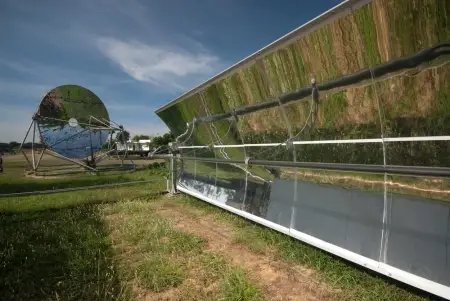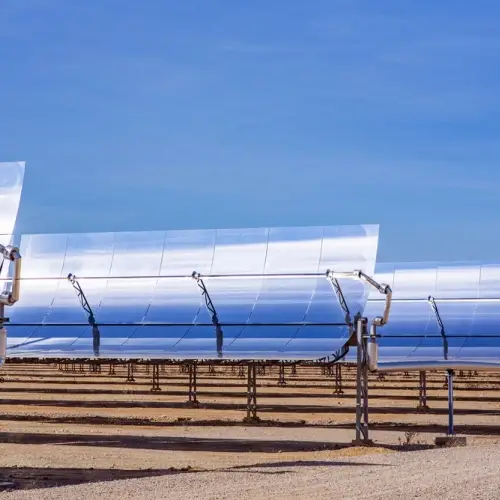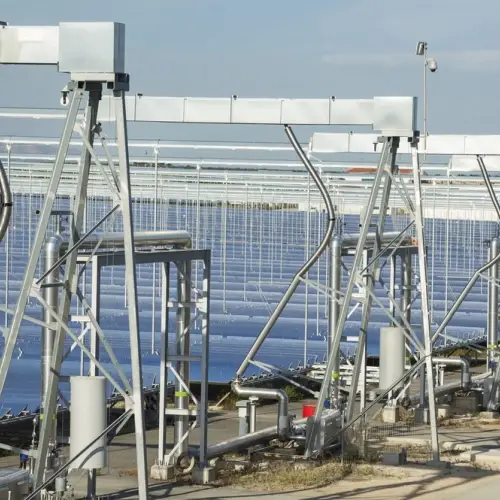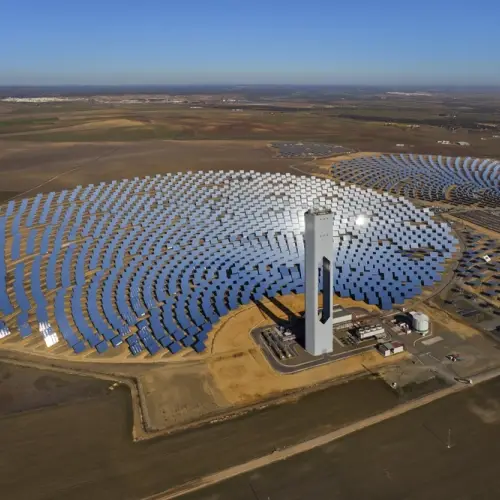
Solar concentrators are devices that capture and concentrate sunlight in a small area to convert it into thermal or electrical energy. The idea is to capture more light in less space, using concentration techniques.
To achieve this goal, mirrors or lenses are used to focus the light on a specific point or line. They are widely used in concentrated solar power plants, which are often located in areas with a lot of sun.
But what types exist and how do they differ?
1. Parabolic trough concentrators
This type of concentrator is one of the most common and widely used in the world of concentrated solar energy.
 Imagine a long U-shaped channel that curves to create a parabola, like a long, curved mirror. This channel or collector has mirrors on its inner surface that concentrate the light into a line.
Imagine a long U-shaped channel that curves to create a parabola, like a long, curved mirror. This channel or collector has mirrors on its inner surface that concentrate the light into a line.
How does it work?
Sunlight hits the mirrors and, due to the parabolic shape, is concentrated in a receiver tube located right at the focus of the parabola. Inside this tube there is usually a heat transfer fluid (such as a special oil) that is heated by the concentrated light. This heat can be used directly or to produce steam to power a turbine and generate electricity.
These concentrators are ideal in areas where the sun is at a fairly constant height, as they only need to be tracked on one axis to follow the sun's position. They are very efficient, but they are limited to capturing direct sunlight, meaning they don't work as well on cloudy days.
Parabolic trough concentrators typically reach temperatures of up to 400°C, allowing pressurized steam to be generated to drive turbines and produce electricity. This type of plant also allows thermal energy to be stored in molten salts, meaning it can continue to generate electricity even after the sun has set.
Example
The Solana solar farm in Arizona, USA, is one of the largest examples of an installation using parabolic trough concentrators.
This plant has a capacity of 280 MW, enough to supply electricity to approximately 70,000 homes.
2. Linear Fresnel concentrators
Similar to the above, linear Fresnel concentrators also use a linear structure, but instead of using a curved parabolic mirror, they employ a series of flat or nearly flat mirrors placed at different angles.
 These mirrors are arranged in rows and focus sunlight onto a receiver tube, located at a high distance above the mirrors.
These mirrors are arranged in rows and focus sunlight onto a receiver tube, located at a high distance above the mirrors.
The advantage of Fresnels over parabolic ones is that they are simpler and cheaper to build, because flat mirrors are less expensive than curved mirrors. They also allow for a compact arrangement, so you can fit more units in a limited space.
However, their efficiency is somewhat lower, as the flat design does not concentrate light as precisely as a parabola. These concentrators require less maintenance, but like parabolic troughs, they depend on direct sunlight.
Linear Fresnel concentrators typically reach temperatures between 250°C and 300°C and are of a somewhat simpler design. They are more compact than parabolic trough concentrators and can be installed on flat or slightly sloping terrain.
Example
The Puerto Errado 2 solar plant in Calasparra, Spain, is a notable example of a solar plant with linear Fresnel concentrators. With a capacity of 30 MW, this facility leverages Fresnel technology to generate electricity in a region of high solar irradiation.
3. Solar tower concentrators
These are impressive and often eye-catching because of their size and design. Instead of curved or flat mirrors lined up in a channel, solar towers use a large number of mirrors called heliostats, which surround a central tower.
 Each heliostat is individually controlled to track the sun and reflect light back to the top of the tower, where the receiver is located.
Each heliostat is individually controlled to track the sun and reflect light back to the top of the tower, where the receiver is located.
The receiver in the tower is a container that holds a special fluid, often molten salts, which can reach extremely high temperatures. These hot salts are then used to generate steam and drive a turbine that generates electricity.
One of the strengths of this system is that the salts can store heat for several hours, allowing electricity to be generated even after the sun has set.
Solar towers have very high efficiency and are capable of generating large amounts of energy, but they require a large initial investment and are intended for large plants in cleared areas with high solar irradiation. Due to their need for a large space and an advanced tracking system, solar towers are not as common as linear concentrators.
Solar towers can reach temperatures of over 565°C thanks to the use of molten salts as a heat transfer medium. This high heat allows thermal energy to be stored for several hours, so plants with solar towers can provide electricity even when the sun is no longer shining. This makes them a competitive option compared to traditional energy sources, with a storage efficiency of 85-90%.
Example
The Ivanpah Solar Farm in California, USA, is the world's largest solar tower, with a total capacity of 392 MW. It uses more than 170,000 heliostats, each with two mirrors, to concentrate sunlight onto three receiving towers.
4. Parabolic disk concentrators
These work similarly to a satellite dish, and in some ways even resemble one. They are smaller concentrators and are typically used in stand-alone or smaller systems, not in large-scale generating plants.
 The parabolic dish concentrator uses a dish-shaped parabolic mirror to concentrate sunlight onto a single focal point, where a receiver is located. Unlike parabolic trough concentrators, which concentrate light along a line, parabolic dishes concentrate it onto a single point, which allows very high temperatures to be achieved.
The parabolic dish concentrator uses a dish-shaped parabolic mirror to concentrate sunlight onto a single focal point, where a receiver is located. Unlike parabolic trough concentrators, which concentrate light along a line, parabolic dishes concentrate it onto a single point, which allows very high temperatures to be achieved.
One advantage of parabolic dishes is that they can be powered by a Stirling engine, which is a type of engine that converts heat into motion, without the need for steam or turbines.
These motors are especially useful in decentralized applications, where the energy generated can be used immediately or stored.
They also have fairly high efficiency, but are usually more expensive and require a dual-axis solar tracking system.
Parabolic dish concentrators can reach temperatures of up to 750°C as they concentrate sunlight into a single point. This makes them ideal for operating Stirling engines, which convert heat directly into electricity without the need for a turbine. Each parabolic dish unit generates between 3 and 25 kW.
Examples
The Big Dish parabolic dish project in Canberra, Australia, (pictured) is an example of a smaller-scale installation.
5. Fresnel lens concentrators
This type of concentrator uses a Fresnel lens instead of mirrors. Fresnel lenses are flat lenses made of multiple concentric rings that allow light to be concentrated at a point without needing as much thickness as a conventional lens. They are known for allowing light to be concentrated in a compact and lightweight design.
They are more commonly used in photovoltaic solar applications rather than thermal ones. That is, the concentrated light is used directly to generate electricity using solar cells.
These systems are typically used in small to medium-scale installations and in portable applications such as in vehicles and buildings. Although they are less expensive than other concentrators, they are somewhat less efficient and subject to overheating, so they often require a cooling system.